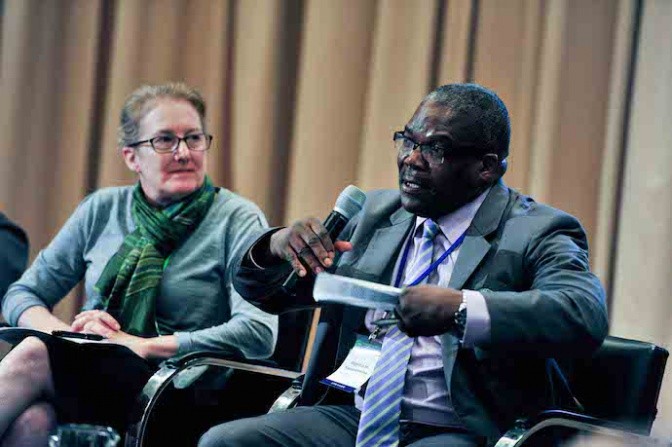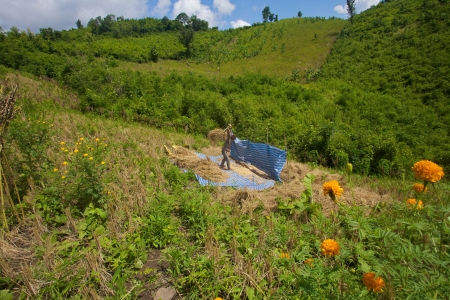This post is part of an online discussion on large-scale land interventions that runs through December 14, 2014. Can these initiatives fulfil their promises? Read more here and comment below or send an 800 word response to a.waldorf@cgiar.org.
The enthusiastic launch of Initiative 20x20 last Sunday at the Global Landscape Forum (held alongside the UN Climate Change Conference in Lima, Peru) sent a clear signal that restoring degraded land is winning major support from governments and even private investors.
The reasons for heightened concern are well known – increasing land scarcity, increasing foreign direct investment in land, rising demand for food, population pressure on marginal land, deteriorating ecosystem services – all of which threaten food security.
 Aloysius Kamperewera and Leslie Durschinger discuss the conditions for gaining political and financial support for landscapes approaches. Photo: Neil Palmer/IWMI
Aloysius Kamperewera and Leslie Durschinger discuss the conditions for gaining political and financial support for landscapes approaches. Photo: Neil Palmer/IWMIThe Millennium Ecosystem Assessment marked the beginning of the turnaround for support for restoring degraded land. Later, the Bonn Challenge set the pattern of defining specific targets for land restoration, especially in forest landscapes. More recently, Rio+20 drew attention to the idea of “zero net land degradation” as one principle of the new sustainable development goals.
The good news is that growing concern is giving rise to action, as evidenced by Initiative 20x20, which aims to restore 20 million hectares of degraded forest land in Latin America by 2020. An important feature of the initiative is that it sets quantitative targets, by country, along the lines of the Bonn Challenge. It also features explicit political and financial commitments, which are essential for reaching the country targets.
No one-size-fits-all solution
With momentum building in support of initiatives like 20x20, the CGIAR Research Program on Water, Land and Ecosystems (WLE) and the International Center for Tropical Agriculture (CIAT) have embarked jointly along with other partners on a search for ways to ensure that these efforts deliver results that meet the expectations of committed governments and financial investors.
The landscapes we focus on are diverse, encompassing crop land and pastures as well as forests under varying degrees of pressure. Moreover, we take into account not just the productive capacity of these landscapes, but also their other uses – whether for urban water supplies, natural resource extraction, or cultural purposes.
Just as landscapes vary, so does land restoration, and consequently, there can be no one-size-fits-all solutions. On the contrary, each initiative requires a unique combination of policy, financial, and science components to ensure success – in terms of restored ecosystem services, more sustainable crop production, and tangible benefits for marginalized groups, including women.
During a Global Landscapes Forum session organized by CIAT with the CGIAR Research Program on Water, Land and Ecosystems, panelists talked about the importance of securing political and financial commitments for efforts like 20x20.
To help get this combination right for each case, we posed four key questions in our work. Our panelists answered:
- Alexander Müller of the Institute for Advanced Sustainability Studies,
- Leslie Durschinger, Terra Global Capital,
- Tefera Mengistu, Ministry of Environment and Forest in Ethiopia,
- Aloysius Kamperewera, Ministry of Natural Resources, Energy and Environment in Malawi,
- Walter Vergara, World Resources Institute
How can we maximize returns on investment?
Any investment involves uncertainty. But science has ways of reducing uncertainty and increasing the odds that investments will meet their objectives. New modeling tools and participatory approaches better enable us to evaluate investment options and determine which are most likely to boost agricultural productivity, enhance livelihoods, and restore ecosystem services.
“By thus filling knowledge gaps,” said Leslie Durschinger, Founder and Managing Director of Terra Global Capital, “research can demonstrate the viability of deploying capital to create sustainable landscapes, helping in turn to attract more capital.”
What are the best practices?
Whether investments pay off depends on the land-use practices that rural people adopt. CGIAR centers, national research organizations, and many others have developed a wide range of sustainable solutions through decades of research on crop, soil, and land management in every region of the developing world. This knowledge is an enormously valuable resource for helping choose best practices at the regional level and for specific sites.
Whose livelihoods are at stake?
Every hectare of land we’re talking about is occupied or used by someone or some entity. Each has a stake in land restoration and must therefore be represented in key decisions. This is essential for achieving more equitable sharing of both the benefits and responsibilities involved in land restoration. This, in turn, requires that we discover who land users are and what resources they have. To make this information useful for planning, we literally need to put people and their resources on the map.
Who decides and how do we ensure accountability?
As governments and investors provide more and more support for large-scale land restoration, they need strong assurance that their commitments are achieving the desired results. What degree of restoration was achieved? How large are the resulting benefits? Who captured these benefits? Were the needs of women and marginalized people taken into account?
In order to answer these questions, large-scale land restoration initiatives need to have built-in accountability mechanisms that draw on science-based evidence. These mechanisms can take different forms, but they should all ensure transparency, making it clear how the effectiveness of specific investments was judged and by whom.
Accountability and transparency are essential for building confidence, and confidence is key for maintaining the commitment of governments, investors, development agencies, and the rural families whose livelihoods are at stake.


















Comments
Here we are thinking of investment for landscaping and conservation of water etc. in doubt. May it be Government or Private Sector, investment aims at return. In this juncture we can think of the family farmers who at times are not sure of their ownership on the land used by them to feed their family and others. They are afraid of being snatched are deprived of their cultivated land for other purposes for greater interest of public (!) as decided by government and for vested interest at times by other sector. It is high time that while thnking of conservation, these family farmers does not suffer much.
Add new comment